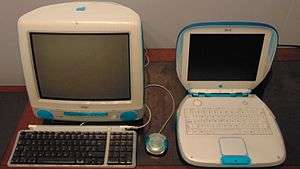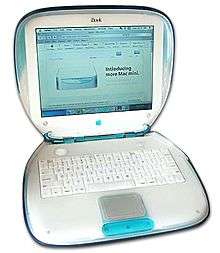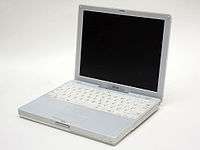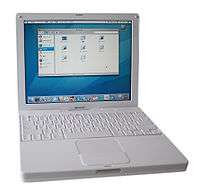iBook
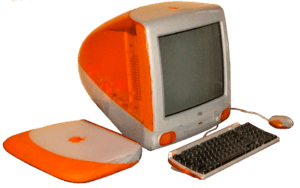
The iBook was a line of laptop computers designed and marketed by Apple Inc. from 1999 to 2006. The line targeted entry-level, consumer and education markets, with lower specifications and prices than the PowerBook, Apple's higher-end line of laptop computers. It was the first mass consumer product to offer Wi-Fi network connectivity, which was then branded by Apple as AirPort.[1][2]
The iBook had three different designs during its lifetime. The first, known as the "Clamshell," was inspired by the design of Apple's popular iMac line at the time. It was a significant departure from previous portable computer designs due to its shape, bright colors, incorporation of a handle into the casing, lack of a display closing latch, lack of a hinged cover over the external ports and built-in wireless networking. Two years later, the second generation abandoned the original form factor in favor of a more conventional, rectangular design. In October 2003, a third iteration was released that added a PowerPC G4 chip and a slot-loading drive.
Apple replaced the iBook line with the MacBook in May 2006 during Apple's transition to Intel processors. The MacBook has also evolved into different models, such as the MacBook Pro targeting high performance and the MacBook Air targeting the entry-level, ultra-portable laptop market.
They were also a major name for education, with Henrico County Public Schools being the first of many school systems in the United States to distribute one to every student.
iBook G3 ("Clamshell")
|
The original iBook in Blueberry color | |
| Developer | Apple Computer Inc |
|---|---|
| Type | Consumer laptop |
| Release date | June 21, 1999 |
| Discontinued | May 1, 2001 |
| CPU | PowerPC G3, 300–466 MHz |
| Successor | iBook G3 (Snow) |
In the late 1990s, Apple was trimming its product line from the bewildering variety of intersecting Performa, Quadra, LC, Power Macintosh and PowerBook models to a simplified "four box" strategy: desktop and portable computers, each in both consumer and professional models. Three boxes of this strategy were already in place: The newly introduced iMac was the consumer desktop, the Blue and White G3 filled the professional desktop box, and the PowerBook line served as the professional portable line. This left only the consumer portable space empty, leading to much rumor on the Internet of potential designs and features. Putting an end to this speculation, on June 21, 1999, Steve Jobs unveiled the iBook G3 during the keynote presentation of Macworld Conference & Expo, New York City.
Like the iMac, the iBook G3 had a PowerPC G3 CPU, and no legacy Apple interfaces. USB, Ethernet, modem ports and an optical drive were standard. The ports were left uncovered along the left side, as a cover was thought to be fragile and unnecessary with the iBook's new interfaces, which lacked the exposed pins of earlier connectors. When the lid was closed, the hinge kept it firmly shut, so there was no need for a latch on the screen. The hinge included an integrated carrying handle. Additional power connectors on the bottom surface allowed multiple iBook G3s to be charged on a custom-made rack. The iBook G3 was the first Mac to use Apple's new "Unified Logic Board Architecture," which condensed all of the machine's core features into two chips, and added AGP and Ultra DMA support.
The iBook was the first mainstream computer designed and sold with integrated wireless networking.[3] On the iBook's introduction, Phil Schiller, Apple's VP of Marketing, held an iBook while jumping off a height as data from the computer was transferred to another in order to demonstrate the wireless networking capability. The display bezel contained the wireless antenna, which attached to an optional internal wireless card. Lucent helped create this wireless capability which established the industry standard. Apple released the AirPort Wireless Base Station at the same time.
There was heated debate over many things such as the aesthetics, features, weight, performance and pricing.[4][5] To provide sufficient impact protection, the iBook was larger and heftier than the PowerBook of the time, and yet had lower specifications. Standard features like PC card slots were absent, and so were speculated features such as touch screens and an ultra-long battery life. The iBook gained the label "Barbie's toilet seat," due to the distinctive design.[6] Nevertheless, this same design made the iBook G3 unmistakable in movies and television shows.
The iBook was a commercial success.[7] The line continually received processor, memory, hard disk upgrades and new colors. FireWire and video out were later added. The design was discontinued in May 2001, in favor of the new "Dual USB" iBooks.
Design
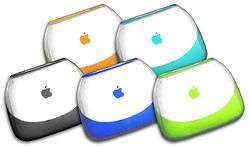
The design was clearly influenced by Apple's consumer desktop, the iMac. In fact, one of the marketing slogans for the iBook was "iMac to go." The clamshell design also echoed the eMate 300. Apple continued its trend of using transparent colored plastics for the shell, and released the iBook clamshell series in several colors, starting with Blueberry and Tangerine, later adding Indigo, Graphite and Key Lime colors. However, unlike the iMac, all iBook except for the original Graphite did not use pinstripes. Steve Jobs announced that the Key Lime color, "a little less conservative, a little more fun", was exclusive to the online Apple Store. This resulted in some crowd members booing, to which Jobs replied: "Don't you like buying on the Apple Online Store?"[8]
Compared to follow-up iBook and PowerBook notebook computers, the Clamshell iBook proved to be the more reliable model.[9] The original iBook is on exhibition at the London Design Museum and the Yale University Art Gallery.[10][11] Vestiges of design ideas first adopted in the iBook G3 can still be seen today: moving interface ports from the back to the sides and leaving them uncovered, omitting a latch for the computer's lid and providing color options and an eye-catching design intended to be seen with the computer open.
Models
| iBook G3 Clamshell | ||||
|---|---|---|---|---|
| Model | iBook | iBook SE (Special Edition) | iBook (FireWire), iBook (FireWire) SE | |
| Release date | June 21, 1999 | February 16, 2000 | September 13, 2000 | |
| Color(s) |
(Special Edition) (SE and regular) | |||
| Order number | M7707LL/A*[12] | M7716LL/A* | M7721LL/A*, M7720LL/A* (special edition) | |
| Model identifier | Powerbook 2,1 | Powerbook 2,2 | ||
| Model number | M2453 | M2453 | M6411 | |
| Processor | 300 MHz PowerPC G3 (750) | 366 MHz PowerPC G3 (750) | 366 MHz (regular) or 466 MHz (SE) PowerPC G3 (750cxe) | |
| Cache | 64kb L1, 512kb L2 backside cache (1:2) | 64kb L1, 256kb L2 cache (1:1) | ||
| Front side bus | 66 MHz | |||
| Memory | 32 MB or 64 MB of PC66 SDRAM (soldered to the logic board) Expandable to 544 MB or 576 MB (288 MB or 320 MB specified by Apple) |
64 MB of PC66 SDRAM (soldered to the logic board) Expandable to 576 MB (320 MB specified by Apple) |
64 MB of PC100 SDRAM (soldered to the logic board) Expandable to 576 MB (320 MB specified by Apple) | |
| Display | 12" active-matrix TFT display, 800×600 pixel resolution | |||
| Graphics | ATI Rage with 4 MB of SDRAM | ATI Rage 128 with 8 MB of SDRAM | ||
| AGP 2x | ||||
| Hard drive | 3.2 GB or 6 GB ATA | 6 GB ATA | 10 GB ATA | |
| Optical drive Tray loading |
24× CD-ROM | 24× CD-ROM (regular) or 4× DVD-ROM (SE) | ||
| Connectivity | Optional AirPort 802.11b 10/100 BASE-T Ethernet 56k V.90 modem | |||
| Peripherals | 1x USB 1.1 Audio out mini-jack |
1x USB 1.1 1x Firewire 400 Audio out mini-jack | ||
| Video out | N/A | Composite video out | ||
| Battery | 45-watt-hour removable lithium-ion | |||
| Original Operating System | Mac OS 8.6 | Mac OS 9.0.2 | Mac OS 9.0.4 | |
| Maximum Operating System | Mac OS X 10.3.9 "Panther" and Mac OS 9.2.2 Unofficially, can run Mac OS X 10.4 “Tiger” using XPostFacto |
Mac OS X 10.4.11 "Tiger" and Mac OS 9.2.2 | ||
| Weight | 6.7 lbs / 3.0 kg | |||
| Dimensions | 1.8×13.5×11.6 inch / 4,6 x 34,3 x 29,5 cm | |||
Expandability and upgrades
The original iBook's only customer-serviceable parts were the RAM and AirPort card, accessed via two slots under the keyboard. No other modifications were possible in-warranty. There was no PCMCIA port for additional expansion capabilities. 40 screws needed to be removed to access the hard drive. The optical drive, however, can be accessed far more easily, requiring only 11 screws and one standoff to be removed. Later on, some users transplanted a 1024×768 LCD from the more recent white iBook into a clamshell iBook. This is only possible with the "FireWire" and "FireWire SE" models, as they have 8 MB of video RAM; the older ones only have 4 MB.[13]
All clamshell iBooks shipped with Mac OS 8.6 or 9.0. All clamshell iBooks supported Mac OS X 10.0 through 10.3.9. Mac OS X v10.4 "Tiger", which requires a FireWire port, can also be installed, though only on the late-model iBook G3 FireWire/SE (366/466 MHz). It is possible to use third-party software such as XPostFacto to install version 10.4 on earlier clamshell iBooks.
iBook G3 Dual USB ("Snow")
|
The second-generation iBook G3 "snow" (12.1 in). | |
| Developer | Apple |
|---|---|
| Type | Consumer laptop |
| Release date | May 1, 2001 |
| Discontinued | October 22, 2003 |
| CPU | PowerPC G3, 500–900 MHz |
| Predecessor | iBook G3 Clamshell |
| Successor | IBook G4 Snow |
Apple debuted the next-generation iBook G3 at a press conference in Cupertino, California, on May 1, 2001. The previous bold colors and bulky form-factor were abandoned, as were the handle, latch-less design and additional power connectors on the bottom surface.
The resulting iBook was available in white only, hence the name "Snow" and incorporated transparent polycarbonate in its casing. It was 30% lighter, and occupied less than half of the volume of the model it replaced, being smaller in all three dimensions. Despite that, it added an extra USB port and a higher resolution screen. Apple claimed the compact design did not sacrifice durability, saying it was "twice as durable" as the previous model.
With this revision, Apple began transitioning to translucent and white polycarbonate casings in most of its consumer line, such as the iMac and the eMac. In contrast, most of its professional products used an anodized aluminum finish. Near the end of its run, the Snow iBook G3 case became opaque and white instead of translucent white and magnesium.
Models
| iBook G3 Dual USB | |||||||
|---|---|---|---|---|---|---|---|
| Model | iBook (Dual USB) | iBook (Late 2001) | iBook (14") | iBook (16 VRAM) | iBook (Late 2002) | iBook (Early 2003) | |
| Release date | May 1, 2001 | October 16, 2001 | January 7, 2002 | May 20, 2002 | November 6, 2002 | April 22, 2003 | |
| Color | Translucent White | Translucent White (800 MHz) Opaque White (700 MHz) |
Opaque White | ||||
| Order number | M7698LL/A (64 MB, CD-ROM), M7692LL/A (128 MB, DVD-ROM), M8520LL/A (128 MB, Combo Drive) | M8597LL/A (500 MHz), M8598LL/A* (600 MHz DVD-ROM), M8599LL/A* (600 MHz Combo Drive) | M7701LL/A | M8600LL/A (600 MHz), M8602LL/A (700 MHz), M8603LL/A (14") | M8860LL/A (700 MHz), M8861LL/A (800 MHz), M8862LL/A (14") | M8758LL/A (800 MHz), M9018LL/A (900 MHz), M9009LL/A (14") | |
| Model identifier | PowerBook 4,1 | PowerBook 4,2 | PowerBook 4,3 | ||||
| Model number | M6497 | M8413 | A1005 (12") A1007 (14") | ||||
| Processor | 500 MHz PowerPC G3 (750cxe) | 500 MHz or 600 MHz PowerPC G3 (750cxe or 745/755) | 600 MHz PowerPC G3 (745/755) | 600 MHz (12") 700 MHz (12" and 14") PowerPC G3 (750fx) |
700 MHz (12") 800 MHz (12" and 14") PowerPC G3 (750fx) |
800 MHz (12") 900 MHz (12" and 14") PowerPC G3 (750fx) | |
| Cache | 64kb L1, 256kb L2 cache (1:1) | 64kb L1, 512kb L2 cache (1:1) | |||||
| Front side bus | 66 MHz | 66 MHz (500 MHz) or 100 MHz (600 MHz) | 100 MHz | ||||
| Memory | 64 MB or 128 MB of PC100 SDRAM (soldered to the logic board) Expandable to 576 MB or 640 MB |
128 MB of PC100 SDRAM (soldered to the logic board) (12") 256 MB of PC100 SDRAM (128 MB soldered to the logic board) (14") Expandable to 640 MB | |||||
| Display | 12.1" TFT XGA active matrix display, 1024×768 pixel resolution | N/A | 12.1" TFT XGA active matrix display, 1024×768 pixel resolution | ||||
| N/A | 14.1" TFT XGA active matrix display, 1024×768 pixel resolution | ||||||
| Graphics | ATI Rage 128 with 8 MB of SDRAM | ATI Radeon with 16 MB of SDRAM | ATI Radeon 7500 with 16 MB (700 MHz) or 32 MB (800 MHz) SDRAM | ATI Radeon 7500 with 32 MB SDRAM | |||
| AGP 2x | |||||||
| Hard drive | 10 GB | 15 GB or 20 GB | 20 GB | 20 GB (12" only) or 30 GB | 30 GB (800 MHz) or 40 GB (900 MHz) | ||
| Ultra/ATA | |||||||
| Optical drive Tray-loading |
CD-ROM, DVD-ROM, CD-RW or DVD-ROM/CD-RW Combo Drive | DVD-ROM/CD-RW Combo Drive | CD-ROM (600 MHz) DVD-ROM/CD-RW Combo Drive (700 MHz) |
CD-ROM (700 MHz) DVD-ROM/CD-RW Combo Drive (800 MHz) |
CD-ROM (800 MHz) DVD-ROM/CD-RW Combo Drive (900 MHz) | ||
| Connectivity | Optional AirPort 802.11b 10/100 BASE-T Ethernet 56k V.90 modem | ||||||
| Peripherals | 2x USB 1.1 1x Firewire 400 Audio out mini-jack | ||||||
| Video out | A/V Port (VGA, composite video/sound) via adaptors | Mini-VGA (VGA, composite and S-Video) via adaptors | |||||
| Original Operating System | Mac OS 9.1 | Mac OS 9.2.1 / Mac OS X 10.1 | Mac OS 9.2.2 / Mac OS X 10.1.4 | Mac OS 9.2.2 / Mac OS X 10.2.1 | Mac OS 9.2.2 / Mac OS X 10.2.4 | ||
| Maximum Operating System | Mac OS X 10.4.11 "Tiger" and Mac OS 9.2.2 | ||||||
| Weight | 4.9 lbs (2.2 kg) | 5.9 lbs / 2.7 kg | 4.9 lbs (2.2 kg) (12") 5.9 lbs / 2.7 kg (14") | ||||
| Dimensions | 1.35 x 11.2 x 9.6 inches / 3.4 x 28.5 x 23.0 cm | 1.35 x 12.7 x 10.2 inches / 3.4 x 32.3 x 25.9 cm | 1.35 x 11.2 x 9.6 inches / 3.4 x 28.5 x 23.0 cm (12") 1.35 x 12.7 x 10.2 inches / 3.4 x 32.3 x 25.9 cm (14") | ||||
iBook G4 ("Snow")
|
iBook G4 (12 inch) | |
| Developer | Apple Computer |
|---|---|
| Type | Consumer laptop |
| Release date | October 22, 2003 |
| Discontinued | May 16, 2006 |
| CPU | PowerPC G4, 800 MHz – 1.42 GHz |
| Predecessor | iBook G3 Snow |
| Successor | MacBook |
Apple added a PowerPC G4 chip to the iBook line on October 23, 2003, finally ending Apple’s use of the PowerPC G3 chip. A slot-loading optical drive replaced the disc tray. The iBook G4 also features an opaque white case finish and keyboard and a plastic display hinge.
Models
| iBook G4 | |||||
|---|---|---|---|---|---|
| Model | iBook G4 | iBook G4 (Early 2004) | iBook G4 (Late 2004) | iBook G4 (Mid 2005) | |
| Release date | October 22, 2003 | April 19, 2004 | October 19, 2004 | July 26, 2005 | |
| Color | Opaque White | ||||
| Order number | M9164LL/A (800 MHz), M9388LL/A (933 MHz), M9165LL/A (1 GHz) | M9426LL/A (12" 1.07 GHz), M9418LL/A (14" 1.07 GHz), M9419LL/A (1.2 GHz) | M9623LL/A (12"), M9627LL/A* (14" Combo Drive), M9628LL/A (14" SuperDrive) | M9846LL/A (12"), M9848LL/A (14") | |
| Model identifier | PowerBook 6,3 | PowerBook 6,5 | PowerBook 6,7 | ||
| Model number | A1054 (12") A1055 (14") |
A1133 (12") A1134 (14") | |||
| Processor | 800 MHz (12") 933 MHz or 1 GHz (14") PowerPC G4 (7455) |
1.07 GHz (12" and 14") 1.2 GHz (14") PowerPC G4 (7447A) |
1.2 GHz (12") 1.33 GHz (14") PowerPC G4 (7447A) |
1.33 GHz (12") 1.42 GHz (14") PowerPC G4 (7447A) | |
| Cache | 64 KB L1, 256 KB L2 Cache (1:1) | 64 KB L1, 512 KB L2 Cache (1:1) | |||
| Front side bus | 133 MHz | 133 MHz (12") 142 MHz (14") | |||
| Memory | 256 MB of 266 MHz PC2100 DDR SDRAM (128 soldered to logic board) Expandable to 1.12 GB |
256 MB of 266 MHz PC2100 DDR SDRAM (soldered to logic board) Expandable to 1.25 GB |
512 MB of 333 MHz PC2700 DDR SDRAM (soldered to logic board) Expandable to 1.5 GB | ||
| Display | 12.1" TFT XGA active matrix display, 1024×768 pixel resolution | ||||
| 14.1" TFT XGA active matrix display, 1024×768 pixel resolution | |||||
| Graphics | ATI Radeon 9200 with 32 MB of SDRAM | ATI Radeon 9550 with 32 MB of SDRAM | |||
| AGP 4x | |||||
| Hard drive | 30, 40, or 60 GB 4200-rpm | 30, 60, or 80 GB 4200-rpm | 40, 60, 80, or 100 GB 4200-rpm | ||
| Ultra/ATA 100 | |||||
| Optical drive Slot-loading |
DVD-ROM/CD-RW Combo Drive | DVD-ROM/CD-RW Combo Drive or optional DVD±RW SuperDrive | DVD-ROM/CD-RW Combo Drive or optional DVD±RW SuperDrive (12") DVD-RW SuperDrive (14") | ||
| Connectivity | Optional AirPort Extreme 802.11b/g 10/100BASE-T Ethernet 56k v.92 modem Optional Bluetooth 1.1 |
Integrated AirPort Extreme 802.11b/g 10/100BASE-T Ethernet 56k v.92 modem Optional Bluetooth 1.1 |
Integrated AirPort Extreme 802.11b/g 10/100BASE-T Ethernet 56k v.92 modem Integrated Bluetooth 2.0+EDR | ||
| Peripherals | 2x USB 2.0 1x FireWire 400 Audio out mini-jack | ||||
| Video out | Mini-VGA (VGA, composite and S-Video) via adaptors | ||||
| Original Operating System | Mac OS X 10.3 “Panther” | Mac OS X 10.4 “Tiger” | |||
| Maximum Operating System | Mac OS X 10.4.11 "Tiger" (12") Unofficially can run Mac OS X 10.5 "Leopard" with a RAM upgrade Mac OS X 10.5.8 "Leopard" (14") If less than 512MB of RAM are installed, then only 10.4.11 |
Mac OS X 10.5.8 "Leopard" If less than 512MB of RAM are installed, then only 10.4.11. | Mac OS X 10.5.8 "Leopard" | ||
| Weight | 4.9 lbs / 2.2 kg (12") 5.9 lbs / 2.7 kg (14") | ||||
| Dimensions | 1.35 x 11.2 x 9.1 inches / 3.4 x 28.4 x 23.1 cm (12") 1.35 x 12.7 x 10.2 inches / 3.4 x 32.3 x 25.9 cm (14") | ||||
Expandability and upgrades
The iBook keyboard lifts up, allowing installation of the AirPort (wireless) card and additional memory. This gives the keyboard a "spongy" effect, especially in PowerPC G3 models with the translucent keyboard. The "sponginess" was corrected in the PowerPC G4 models.
Accessing the hard disk drive is complex and time-consuming, involving partial disassembly of the unit and the removal of over 20 different-sized screws.
The memory in the iBook G4 is covered by a removable Airport card, and accessible by removing the RAM shield with a Phillips #00 screwdriver. While some of the earlier models (e.g., 800 MHz and 933 MHz) have a specified 640 MB RAM limit, it is possible to have a total of 1.12 GB of RAM installed (128 MB built-in, plus a 1 GB SO-DIMM), or 1.25 or 1.5 GB in the later models with 256 or 512 MB of RAM soldered to the logic board.
Although no longer officially supported by macOS versions beyond those given in the chart above, the system has also been supported via MorphOS (an Amiga compatible OS) since version 3.2.
Notes
- A copy of Marble Blast Gold came preinstalled on a certain version of the iBook G4 as a promotion of the game.
Quality issues
Apple initiated the "iBook Logic Board Repair Extension Program" in January 2004, which covered the expense of repairing display problems of iBook G3 models for three years.[14] In June 2004, the Repair Extension Program was expanded to cover "all White G3 iBooks."[15][16]
The iBook G4 allegedly suffered from display problems similar to those of the iBook G3, but was not covered by the repair extension program. Owners of iBooks that required expensive repairs for these problems submitted new class action lawsuits in December 2006.
On May 2, 2007, the Danish Consumer Board published an extensive 3rd party report[17][18] concerning the Apple iBook G4 logic board issue. A press release[19] referred to the global consequences this could have for possible guarantee claims.
Timeline of portable Macintoshes

References
- ↑ Apple Offers iMac's Laptop Offspring, the iBook, The New York Times, July 22, 1999
- ↑ STATE OF THE ART; Not Born To Be Wired, The New York Times, November 25, 1999
- ↑ Wi-Fi: Apple to leap ahead again - MAC.BLORGE
- ↑
- ↑ The Mac Observer-Hey Apple? Can You Make My iBook Charcoal Gray?
- ↑ REVIEW / iBook looks less different / This time, internal features distinguish Apple's notebook - SFGate
- ↑ Apple's Climb Back to Success, 1999 to 2001
- ↑ EverySteveJobsVideo (September 13, 2000). "Steve Jobs introduces OS X Beta & new iBooks - Apple Paris Expo (2000)". YouTube. Retrieved December 23, 2016.
- ↑ MacInTouch Special Reports: iBook and PowerBook Reliability
- ↑ iBook 1999 + PowerMacG4 - Design, Architecture and Fashion - Design Museum London
- ↑ Yale University Art Gallery - eCatalogue - iBook G3
- ↑ EveryMac.com --A vast reference for e.g. model number, order number and specific information for 'every Macintosh'
- ↑ The iBook Modification Project Archived 2009-07-12 at the Wayback Machine.. Accessed on March 25, 2009
- ↑ Apple.com — Expanded iBook Logic Board Repair Extension Program FAQ
- ↑ Apple.com — Expanded iBook Logic Board Repair Extension Program FAQ
- ↑ iBook Logic Board Repair Extension Program Expanded to All White G3 iBooks, announcement dated late June 2004, found in web archives of Apple support forums.
- ↑ ""iBook G4 Logic Board issue report made under the authority of the Danish Consumer Board"". Archived from the original on October 14, 2007. Retrieved 2007-05-03.
- ↑ "Danes prove Apple iBook G4 has a defect - The INQUIRER" Archived 2007-10-02 at the Wayback Machine.
- ↑ ""Press release about the iBook G4 logic board issue made by the Danish Consumer Board"". Archived from the original on June 9, 2007. Retrieved 2007-05-03.
External links
| Wikimedia Commons has media related to iBook. |
- Apple – Support – Specifications – iBook
- Apple – How to identify your iBook
- Apple "MacBook" filing suggests iBook re-branding
| Preceded by – |
iBook 21 July 1999−2006 |
Succeeded by MacBook |
